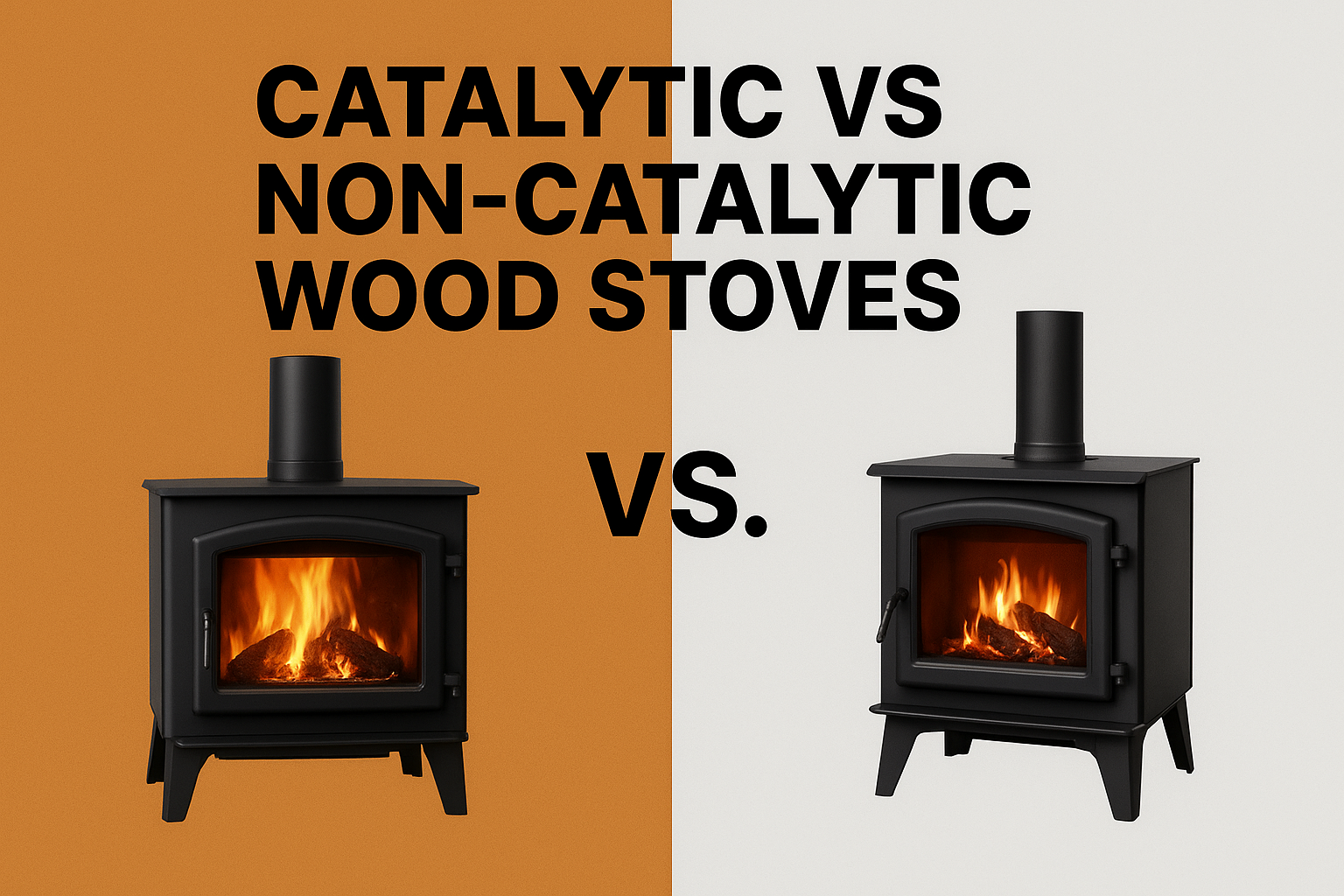Introduction
I’ve been navigating chimneys, tweaking damper settings, and coaxing smoky stoves into clean-burning efficiency for over 20 years. During this time, I’ve guided countless homeowners through the catalytic vs non catalytic wood stove decision. In 2025, with updated EPA Wood Stove Regulations and new technological developments, that choice has never mattered more. Let’s walk through the real-world pros, quirks, and what I’ve seen work best in diverse homes across varied climates. This guide blends what I’ve learned in the field with the latest data from the EPA Certified Wood Heater Database and ongoing industry research.
2025’s Regulatory Landscape: What You Must Know
First off, every new wood stove on the market must be EPA certified, meaning it meets strict emissions standards summed up, these stoves emit no more than 2.0 grams/hour under the crib-wood test, or 2.5 grams/hour using cordwood testing. That’s a big leap from the older limit of 4.5 g/hr, which many pre-2020 stoves used to satisfy.
I always advise clients to inspect the EPA label and, if curious, check the EPA Certified Wood Heater Database for exact emissions, efficiency, and even whether it’s catalytic or non-catalytic. Understanding this is key in the Catalytic vs Non Catalytic Wood Stove decision.
How Catalytic Wood Stoves Work
Let’s get technical, but I’ll keep it friendly.
A catalytic wood stove sits smoke and gases through a ceramic or metallic honeycomb coated with precious metals (platinum, palladium). Think of it like a mini combustion booster: it ignites smoke at around 500°F, vs. the 1,100°F needed in secondary combustion systems.
And yes, real-world performance backs this up: I’ve installed Regency F2500 catalytic models that sneak in 12-hour burns, steady even heat, and noticeably lower fuel use compared to the non-cats in similar settings. One customer on a tight budget after rural delivery told me, “I went from loading four times a day to just twice and my winter wood pile lasted soooo much longer.”
But here’s the trade-off: you’ve got to monitor the bypass damper more closely and use dry, seasoned hardwood. Carelessness can clog the combustor or burn through it fast. Under proper maintenance, though, catalysts can stretch to 8–10 years, sometimes more. Knowing these details helps homeowners navigate the Catalytic vs Non Catalytic Wood Stove choice with confidence.
How Non-Catalytic (Secondary Burn) Stoves Operate

Broader appeal, simpler operation that’s the non-catalytic route.
These stoves rely on a long, insulated baffle, pre-heated air tubes, and carefully controlled airflow to trigger a secondary burn. It’s like giving smoke a second chance to ignite and it works when the stove is hot enough.
From the field, these are easier to use. No catalyst to worry about, no bypass damper twisty dance. Just “fire it up, adjust one lever, and you’re running.” That simplicity is golden for cabins, weekend homes, or folks who just want a cozy fire with minimal fuss.
Efficiency isn’t shabby, these typically hit 60–80%, averaging around 71%, and also meet EPA emission standards. I’ve had clients love how vivid and lively the flames are pure ambiance, without worrying about costly parts replacement.
Efficiency & Performance Face-Off (Catalytic vs Non Catalytic Wood Stove)
The table below highlights the central debate in choosing a Catalytic vs Non Catalytic Wood Stove.
| Feature | Catalytic Stoves | Non-Catalytic Stoves |
|---|---|---|
| Efficiency | 75–85%, especially at low burns | ~60–80% (avg. 71%) |
| Burn Times | 10–12+ hours (steady) | 6–8 hours; quick bursts |
| Heat Output | Gentle, prolonged, stable | Fast, strong burst |
| Emissions | As low as 1–2 g/h in top models | Generally meets ≤2.5 g/h with good design |
| Maintenance | Higher, catalyst needs cleaning/replacement every ~8–10 yrs | Lower (baffle/firebrick upkeep only) |
| Complexity | Moderate, requires some technique | Low (straightforward operation) |
Installation Realities

Stove type aside, every installation begins with these non-negotiables:
- Draft & Chimney Check: Catalytic stoves are more sensitive to draft. I’ve learned the hard way that a sluggish chimney can make the combustor struggle to engage.
- Clearances: Always adhere to manufacturer specs rarely do I tweak clearance rules.
- Outside Air Kits (OAKs): In airtight modern homes, these are lifesavers to prevent negative pressure and back-drafting.
Proper planning reduces headaches in your Catalytic vs Non Catalytic Wood Stove setup. Check out our detailed breakdown in our Wood Stove Heat Shield Requirements Guide for more tips.
Maintenance and Operating Differences
This is where I see the biggest split between homeowners who love catalytic stoves and those who regret them.
Catalytic Wood Stove Maintenance:
- Catalytic combustor replacement every 6–10 years
- Annual inspection and occasional vacuuming of ash buildup
- Strict need for dry, seasoned wood
Non-Catalytic Wood Stove Maintenance:
- Baffle replacement every 5–7 years
- Firebrick and gasket maintenance
- Less sensitive to imperfect firewood
I’ve had customers with catalytic stoves who didn’t realize the combustor had failed until I inspected it. They had essentially been running a smoky, inefficient stove for years. With proper care, though, catalysts can last much longer. For technical specs on catalyst lifespan, Blaze King publishes detailed combustor guidance for their models.
Cost Analysis: Initial Purchase and Long-Term Costs
- Initial Price: Catalytic units cost about $500–$1,000 more.
- Fuel Use: Catalysts stretch wood use up to 30% less per winter.
- Maintenance: More expensive but spread over years.
That farmhouse upgrade I mentioned? The owner recouped the cost difference in two winters thanks to lower wood bills. If your wood is cheap or free, the balance shifts. If you haul or buy it, efficiency counts. This cost breakdown is essential when evaluating a Catalytic vs Non Catalytic Wood Stove for your home.
Which Stove Suits Which Situation?
Here’s how I unpack it with customers:
- Go Catalytic if you:
- Heat continuously over the winter
- Want long overnight burns
- Are eco-conscious and love efficient systems
- Go Non-Catalytic if you:
- Only heat on weekends or holidays
- Prefer low fuss and high flame visibility
- Favor straightforward operation over optimization
In hybrids, like the Lopi NexGen-Hybrid™ you get both benefits, with three-stage combustion: primary, secondary, and catalytic offering supreme efficiency and clean burn.
Busting Some Common Myths
- “Catalytic stoves are maintenance nightmares.” Not true. With proper use and inspection, the combustor can last 8–10 years.
- “Non-cat stoves are dirty.” Not anymore, many meet the 2025 EPA Step 2 standard of ≤2.5 g/h.
- “Hybrid is always better.” It’s great if you need top efficiency and longevity, but pricier and more complex. Choose based on your lifestyle and willingness to maintain.
- “All stoves are the same.” Emission standards, burn tech, real maintenance costs they vary and can affect your comfort, cost, and environmental footprint for years.
Cutting-Edge Trends in 2025 Wood Stove Technology
- Hybrid & Hybrid-Fyre® systems (like Lopi’s) are gaining traction, three-stage combustion gives owners the best of both worlds.
- Smart integration: Wi-Fi sensors, burn-time alerts, and safety notifications are starting to pop up in higher-end units.
- Cleaner burn incentives: Some states now offer rebates or tax incentives for installing catalytic or hybrid stoves under woodsmoke reduction programs.
- Improved real-world testing: The Integrated Duty Cycle (IDC) test, now approved, ensures catalytic and hybrid models perform as promised in real home use.
FAQs About Catalytic vs Non Catalytic Wood Stove
What’s the real difference between catalytic vs non catalytic wood stove?
Catalytic stoves burn smoke through a catalyst at ~500°F for long, efficient burns. Non-cats use hot secondary air and baffles simpler, but with shorter burns and slightly lower efficiency.
Which stove burns cleaner?
Catalytic and hybrid units often hit 1–2 g/h, while well-designed non-cats meet the stronger ≤2.5 g/h Step 2 EPA threshold.
How much maintenance does a catalytic combustor need?
Inspect annually, use only seasoned wood, and expect replacement in 8–10 years if looked after well.
How do I choose between catalytic vs non catalytic wood stove for MY home?
If you burn daily and want efficiency, catalytic (or hybrid) pays off. For simpler, occasional use and low maintenance, non-cat is your friend. And don’t forget to check sizing.
Expert Wrap-Up
Twenty years on and one thing stays consistent: there’s no one “best”, the right stove aligns with how you live, heat, and manage care. Catalytic stoves impress with efficiency and burn time. Non-cats charm with their simplicity and bright flames. Hybrids blend the two for people ready for advanced tech.
My best advice? Be honest with yourself about how you’ll use the stove. If you’re heating full-time through a long winter, the efficiency and burn times of a catalytic stove will serve you well. If you’re heating part-time or want simplicity, a non-cat stove is a fantastic option. Either way, choosing an EPA Wood Stove Regulations compliant stove ensures you’re getting safe, efficient, and environmentally responsible heat.

